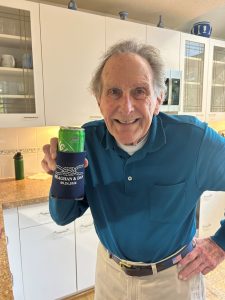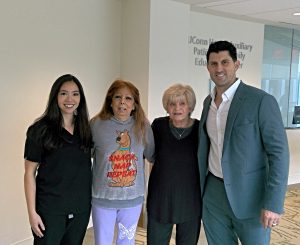Nearly 16 million people in the U.S. have chronic obstructive pulmonary disease (COPD), a serious lung disease that makes it difficult to breathe.
COPD, also known as emphysema or chronic bronchitis develops slowly and can worsen over time. Many people with COPD avoid activities they used to enjoy because they become short of breath so easily. When COPD becomes severe, it can get in the way of doing even the most basic tasks, such as light housekeeping, taking a walk, bathing, and getting dressed.

Three years ago, Dr. Omar Ibrahim, Director of Interventional Pulmonology at UConn Health was the first in Connecticut to perform an endobronchial valve procedure and has completed the procedure on patients who qualify more than anyone else in the state. Two of his grateful patients share how these valves, which they consider to be a miracle have changed their lives.
The endobronchial valve procedure is a minimally invasive treatment option that does not require cutting or incisions. Tiny valves are placed into a targeted section of the diseased lung where the air has become trapped. The trapped air causes shortness of breath. The one-way valve allows the trapped air to be released, resulting in patients being able to breathe easier and experience less shortness of breath. The valve is designed to block off a diseased part of the lungs, which reduces hyperinflation. This allows the healthier parts of the lungs to expand, which can make breathing easier.
The endobronchial valve is recommended for adults with severe COPD emphysema who have reduced lung function and shortness of breath. The valve can help improve lung function and quality of life.
Peter Cawley
More than ten years ago Peter Cawley was diagnosed with COPD emphysema having been a smoker for more than 50 years.
Life with COPD emphysema was difficult, many of the day-to-day activities people take for granted, Cawley struggled with, including talking for long periods of time. He followed the protocols with medications and a rescue inhaler. He slept with oxygen and had to use oxygen whenever his breathing got shallow when he exerted himself. At that time, he thought this was his only option to control his disease.

A family member in Albany, NY saw a story on television about a person who had the endobronchial valve procedure for his COPD and had improved his quality of life. Cawley immediately started researching this procedure, called Medicare to make sure it was covered and discussed it with his primary care physician, Dr. James Stuart. After some further research by Stuart, they both thought it was a good option to explore.
“I live in Rhode Island and didn’t want to go to a city to have the procedure done, so I was thrilled when Dr. Stuart’s office found Dr. Ibrahim at UConn Health,” says Cawley.
“When I first spoke with Dr. Ibrahim, I don’t think he was optimistic that this would work for me, but he said he wanted to give me the benefit of the doubt and agreed to meet with me,” says Cawley.
“I didn’t think he was the best candidate for this procedure due to some borderline heart issues, I knew he would be fine with the procedure but was concerned he would not be able to do the aftercare, however, he was persistent, and he did so well he wanted to come back and do the other lung,” says Ibrahim.
Ibrahim had him go through the course of tests and start pulmonary rehab to see get him ready for the procedure.
“One of the requirements is that you do pulmonary rehab before the procedure so if you are unable to do the pulmonary rehab then you’re probably not a candidate,” says Ibrahim.
Cawley went through a series of tests including X-rays and CT scans, as well as a visit to nuclear medicine at UConn Health to determine if there were fissure nodules on his lungs. He was all ready to get the procedure done and along came COVID-19 which put elective surgeries on hold.
Last year he was finally able to have the procedure and the valves were placed in his left lung, he spent three days in the hospital for evaluation which is part of protocol before being released home.
Since having the valves Cawley and his wife Carol have seen a vast improvement. He goes to the gym three days a week in the early morning to walk the treadmill and on the other days, he rides a recumbent bike. He is stronger and has more energy which has him planning and cooking all their meals.
“When I saw my cardiologist after the procedure, he said my test showed me at 5 to 6 years younger,” says Cawley. “If I can say I got a minimum of five years of quality of life that’s been added, that’s a pretty big benefit.”
While the valves don’t change the progression of the disease, they help him breathe better, improving his quality of life. He still takes his prescribed medicine and uses his oxygen when he needs it but finds he does not need it as much.
“I can now leave the house and don’t even take my cell phone anymore because that’s how confident I feel about his progress, he’s come a long way,” says Peter’s wife Carol Cawley. “It also helps that he has a positive attitude.”
Peter celebrates his 79th birthday this November and bought himself a new car. “I begin my 8th decade with a new car, it’s kind of like a hot rod, all tricked out, and has a loud engine, I wouldn’t be where I am without Dr. Ibrahim, I’m really thankful for all he has done,” says Cawley. “I’m also so thankful for my wife Carol and son Pete for being there to support me through this.”
“Dr. Ibrahim and his staff are phenomenal, every person I encountered at UConn Health was excellent,” says Cawley. “You need to advocate for yourself and that makes a big difference in your healthcare, saying I want to try this and I’m grateful Dr. Ibrahim took the chance on me.”
Heather Butt

Heather Butt learned about the valve procedure from a Facebook post by another UConn Health patient who had the procedure and suggested it. She had also been a long-time smoker but quit in 1996. Then with the emotional toll of her mother passing away in 2004, she started to smoke again. She noticed a change in her breathing in 2011 and her doctor found an aneurysm on her aorta and COPD which lead to open heart surgery and quitting smoking again, this time for good.
The past three years her COPD continued to get worse to the extent she couldn’t take two steps without being able to breathe. She made over 70 trips to the hospital during March through December of last year because it felt like a python was twisting in her diaphragm and she couldn’t breathe, even though her oxygen levels were okay.
Her primary care provider sent a referral to Ibrahim to see if she was a candidate for the endobronchial valve procedure. As with any procedure, Butt was concerned and leery that this would work but Dr. Ibrahim took his time to explain it to her and reassured her.
Butt had four valves placed in her right lung and says, “this is a miracle, I feel like a new person, its amazing something so small can do something so dramatic.”
I went from being an invalid to doing housework, folding laundry, and joining my husband on walks with the dog.
“I am so grateful to Dr. Ibrahim and his team, I love UConn, it’s a beautiful hospital and this procedure was a blessing and a miracle,” says Butt. “I also couldn’t have done it without my husband Tommy, and my sons Eric and RJ who stood by me this last year and I know it was hard on them.”
For more information on the endobronchial valve procedure call 860-679-8300 and ask to speak with Noreen Allsop RN.



